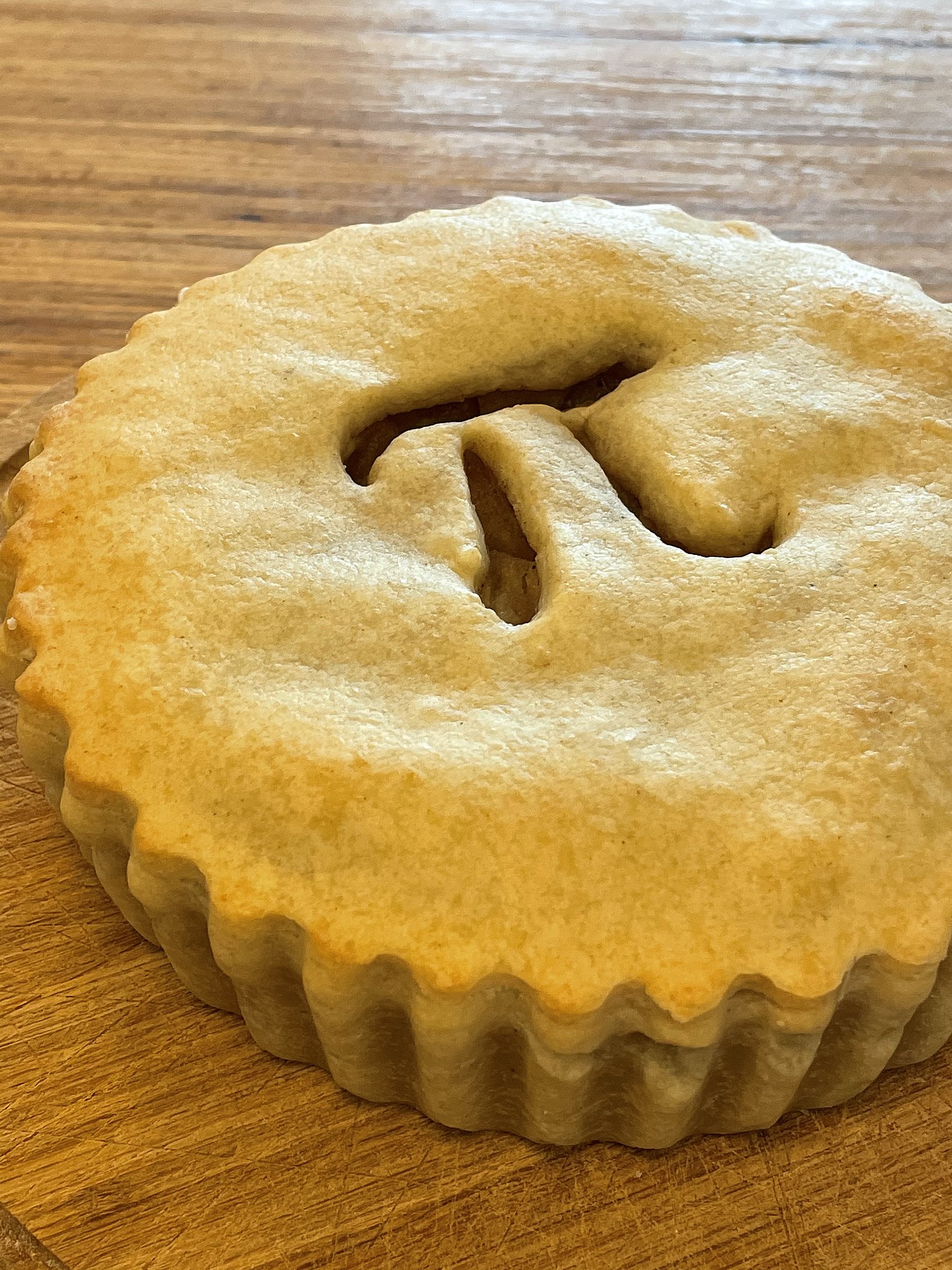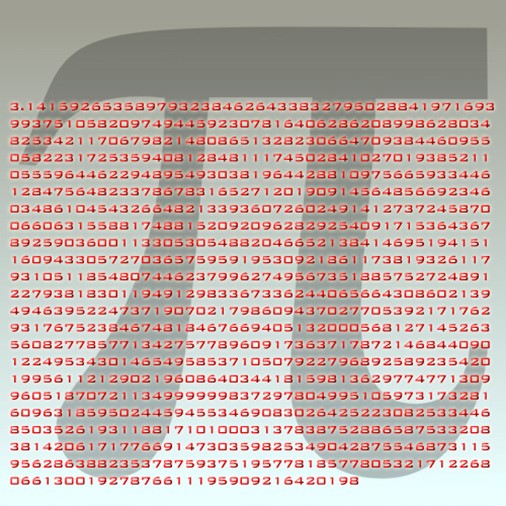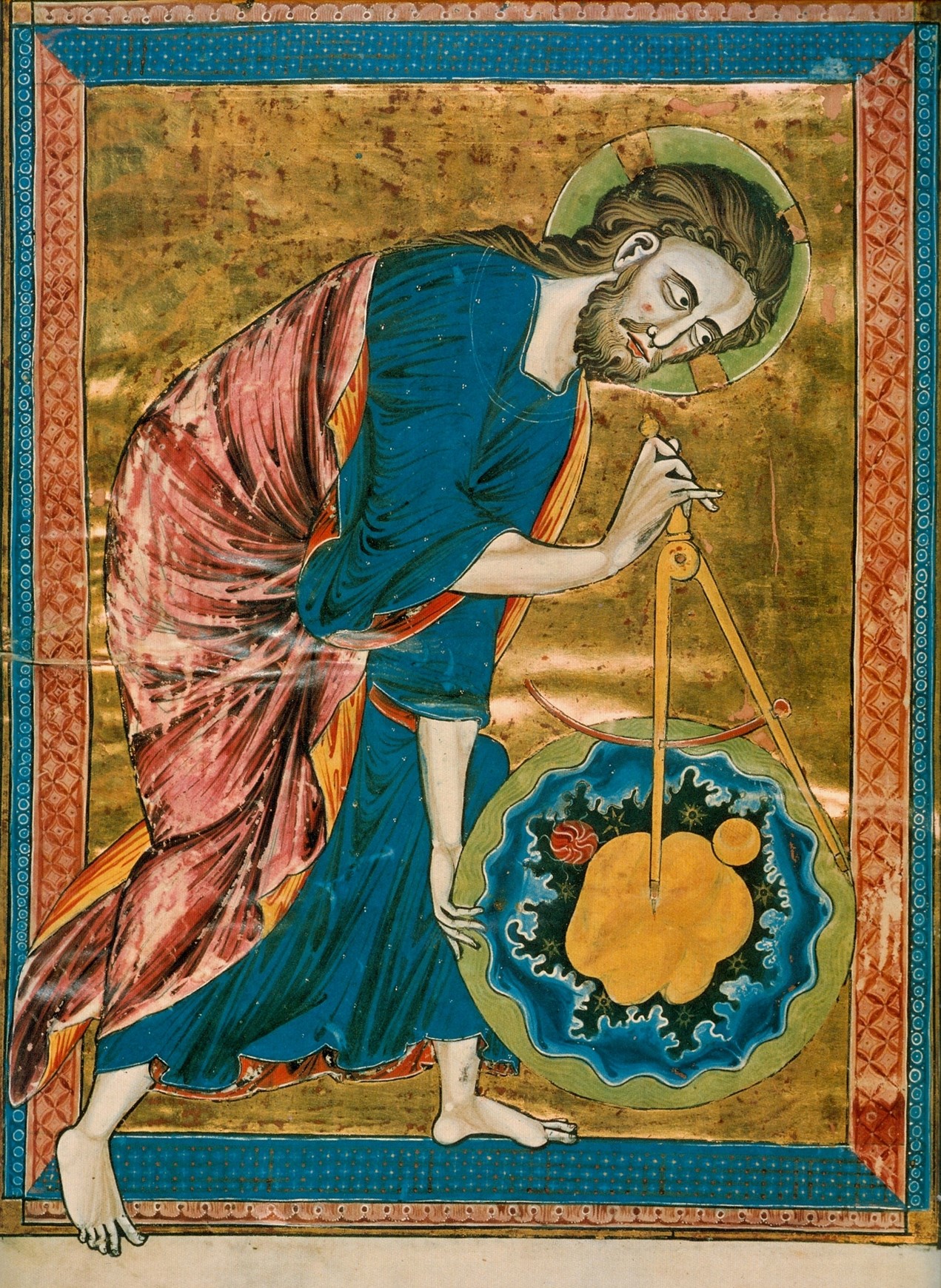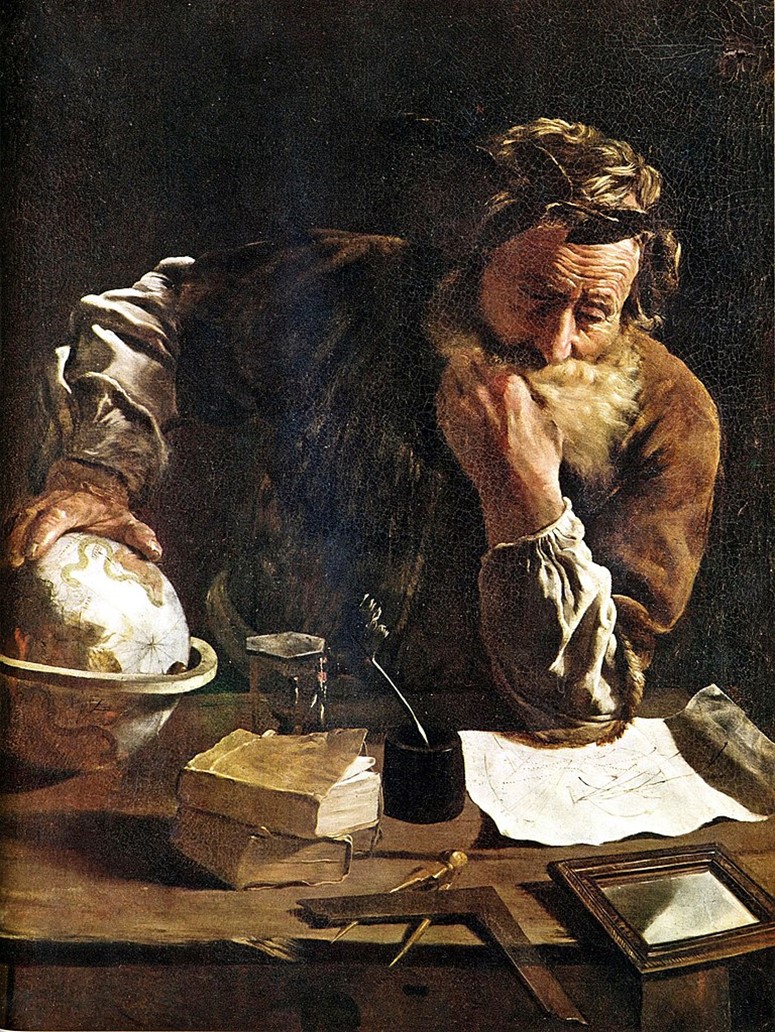
Credit: Shisma, CC BY 4.0, via Wikimedia Commons
The most important number in the universe is arguably … pi. Why? Because it defines circles, spheres and wave motion from atomic to galactic scales.
Pi is the ratio of a circle’s diameter to its circumference. If the diameter is 1, the circumference is pi.
And pi, you may remember, is 3.1415926535 … etcetera, going on forever and never repeating.
It was first recognized 4,000 years ago, and since then, mathematicians have been trying to calculate it.
In 250 BC, the Greek mathematician Archimedes got to 3.14 and change.
1,600 years ago, Chinese mathematician Zu Chongzhi took pi to nine decimals, so accurate that if you used it to calculate Earth’s circumference today, you’d be within a quarter of an inch.
400 years ago, Newton invented calculus, which allowed him to calculate pi to hundreds of digits. Another mathematician proposed the Greek letter pi for the word “perimetros” or “perimeter.” And the name stuck.
Today pi is used in math, science, engineering, architecture, construction and manufacturing, building space ships and planning space flight and much more.
It’s so valuable that congress declared March 14—3.14—National Pi Day. Which coincidentally—or maybe not—is Albert Einstein’s birthday.
Background
Synopsis: The universal constant pi (π) might just be the most important number in the universe. It is a fundamental characteristic of every sphere, circle or arc you see, from electrons to rainbows to the Sun, and it governs all types of circular motion, from springs to jet engines to gravitational waves. It’s so important it has its own holiday, celebrated on 3.14, or March 14th, with math contests and tasty pies.
- When we first start learning about circles, we learn that pi is the circumference of a circle with a diameter of 1, that it equals a little more than 3.14, and that it is represented by the Greek symbol π.
- Pi is an irrational number, meaning it is a real number that can’t be expressed as a simple fraction. A couple of fractions are close, though, like 22/7 (3.1428571 ...) or 355/113 (3.1415929 ...).
- It is also transcendental, meaning it is not the solution to any polynomial formula with rational number coefficients.
- Pi is an infinitely long, nonrepeating decimal that goes on forever without a pattern.
- Its first 100 decimal digits (after the 3) are: 3.1415926535 8979323846 2643383279 5028841971 6939937510 5820974944 5923078164 0628620899 8628034825 3421170679.

First 1,000 digits of pi.
Credit: Tom Murphy, CC BY-SA 3.0, via Wikimedia Commons - Pi is a universal constant, meaning it is the same everywhere in the universe.
- It may well be the most important fundamental constant in the universe because it is vital to the description of shapes like circles and spheres as well as circular motions like rotation and oscillation.
- Pi (π) is the 16th letter of the Greek alphabet and was introduced by William Jones in 1706 for the Greek word “perimetros,” meaning “perimeter.”
- Pi gives us a way to determine the circumference of a circle.
- Circles are the simplest of all the shapes because they have no vertices or angles and are defined by points that are all equidistant from their centers.
- Pi is defined in Euclidean geometry as the ratio of any circle’s circumference to its diameter (π = c/d).
- This means that any circle’s circumference is always equal to pi times its diameter (C = πd = 2πr), regardless of size.

Pi unrolled illustrates the relationship of the diameter (2*r) of a circle to its circumference (C) as C=2πr.
Credit: John Reid, CC BY-SA 3.0, via Wikimedia Commons - The area of a circle is A = π𝑟2.
- Circles have cultural significance, symbolizing unity, harmony, symmetry and balance. They have been used for millennia, from the time of ancient solar and lunar observatories like Stonehenge that date back to at least 3,000 BC through to today’s Olympic rings.
- Pi also gives us a way to describe another essential shape of nature—the sphere.
- Spheres are three-dimensional objects with a single surface defined by the set of points that are all the same distance from the center, perfectly symmetrical.
- The surface area of a sphere is 4π𝑟2.
- The volume of a sphere is 4/3π𝑟3.
- Spheres are special because they have the smallest surface area for a given volume. The smallest documented nearly perfect sphere is an electron, while the largest measured in our solar system is the Sun.
- Every geometrical shape with curves is defined using pi.
- Angles can be measured in two ways, using either degrees or using radians that are tied to pi, leading to even more formulas that depend on pi.
- 360 degrees equals 2π radians, 180 degrees equals π radians, 90 degrees equals 𝜋/2 radians and so on.
- Pi has been recognized as a fundamental constant for at least 4,000 years.
- While they had rough approximations for pi, ancient Egyptians and Babylonians needed reliable estimates of pi for their computations.
- A Babylonian tablet from between 1900 and 1680 BC found pi to be 3.125 using the ratio 25 to 8.
- The Egyptian Rhind Papyrus of 1650 BC gave pi the value of 3.1605.
- Even the Bible includes a passage in the King James Version (I Kings 7:23) that estimates pi at 3:
- “And he made a molten sea, ten cubits from the one brim to the other: it was round all about, and his height was five cubits: and a line of thirty cubits did compass it about.”

“God as architect of the world” as depicted on the frontispiece of one of the Bible moralisée, rare French illustrated copies of the Bible from around AD 1220 to 1230. Science, geometry and astronomy were linked directly to the divine for most medieval scholars. The compass in this thirteenth century manuscript is a symbol of God's act of Creation. God has created the universe after geometric and harmonic principles; to seek these principles was therefore to seek and worship God.
Credit: Austrian National Library, public domain, via Wikimedia Commons
- “And he made a molten sea, ten cubits from the one brim to the other: it was round all about, and his height was five cubits: and a line of thirty cubits did compass it about.”
- Around 250 BC, the Greek mathematician Archimedes attempted the first documented calculation of pi by inscribing and circumscribing polygons with up to 96 sides to find upper and lower limits for the number. He correctly approximated that pi (3.141592) is between 3 and 10/71 (3.14084) and 3 and 10/70 (3.14285). Pi is also known as Archimedes’ constant.

Archimedes Thoughtful (also known as Portrait of a Scholar) by Domenico Fetti, 1620 AD. Archimedes is considered to be one of the greatest mathematicians of the ancient world.
Credit: Domenico Fetti, public domain, via Wikimedia Commons
This cartoon illustrates inscription and circumscription of geometric shapes around a circle. Archimedes approximated pi by starting with a regular hexagon and repeatedly doubling the number of sides until he had a “96-gon,” a polygon with 96 sides of equal length.
Credit: Fredrik Vector, Leszek Krupinski, public domain, via Wikimedia Commons - Around 480 AD, Chinese mathematician Zu Chongzhi, calculated pi to nine decimal places at 3.141592920 using a “24,576-gon.”
- This nine-digit accuracy is also realized by the fraction 355/113, and if used to calculate earth’s circumference of 24,901 miles (40,075 km), it is only off by 0.25 in (0.635 cm) compared to values of pi with hundreds of digits.
- This value stood for more than 800 years until the fourteenth century, when Jamshīd al-Kāshī, a Persian mathematician, used infinite series to calculate pi to 16 places.
- The formal invention of calculus in the seventeenth century enabled the calculation of more than a hundred digits of π.
- In 1706, William Jones gave the constant the pi symbol (π). This usage was popularized by Leonhard Euler in 1737 and beyond.
- In the eighteenth century, a French mathematician called Georges-Louis Leclerc, Comte de Buffon, worked out a way to calculate pi using probability.
- By the start of the ¬¬eighteenth century, 500 digits of pi had been determined, but with new approaches and computer technology, as of 2022, 100 trillion digits have been calculated. Why? Largely to test supercomputers and to break records.
- We will never finish computing pi’s digits. In the December 22, 1967, Star Trek episode “Wolf in the Fold,” a computer hijacked by a fear-mongering serial-killer entity was given the command to “compute to the last digit the value of π” to permanently distract it from taking over the ship. It was an impossible task.
- While they had rough approximations for pi, ancient Egyptians and Babylonians needed reliable estimates of pi for their computations.
- Since it is defined based on the circle and helps to define the sphere, many disciplines rely on pi. Circular motions like rotation and oscillation are also governed by pi.
- In mathematics, some of these topics include trigonometry, geometry, fractal geometry, number theory and statistics.
- In science, they include astrophysics, thermodynamics, electromagnetism, mechanics, electronics, wave theory, biophysics and medicine, to name a few.
- Engineering, construction, manufacturing and architecture all use pi for essential calculations for spacecraft, aircraft, bridges, buildings and infrastructure.
- Most programming languages use radians instead of degrees, so pi influences how your video game characters move through their landscapes.
- Pi is necessary for satellite communication and all the technologies that depend on it, including air travel and space flight.
- The number pi appears in many important calculations, including the Heisenberg uncertainty principle and Einstein’s field equation from general relativity.
- Pi is such an important number, it has been given its own holiday, celebrated every March 14th (3.14).
- In 1988, scientists at the Exploratorium in San Francisco launched Pi Day featuring a circular parade of people carrying the individual numbers of pi around a shrine dedicated to the constant. It was the idea of physicist Larry Shaw.
- Coincidentally, it is Albert Einstein’s Birthday. Born in 1879, he would be 145 years old this Pi Day 2024. The circular parade ends with singing “Happy Birthday dear Albert” while circumnavigating the shrine.
- In 2009, the United States Congress declared March 14 to be Pi Day with a vote of 391 for and 10 against in House Resolution 224.
- 2015 celebrated “Super Pi Day” because the day is written as 3.14.15, so 9:26:53 a.m. was designated “Pi Instant” on that day.
- In 2019, the United Nations designated Pi Day as the International Day of Mathematics at UNESCO’s 40th General Conference.
- Celebrations include eating and throwing pies of all types, pie discounts at restaurants and pizza places and pi recitation contests.
- MIT releases its admissions letters each March 14th, with decisions due on June 28th (2π), honoring math, science and the famous constant.
- Math fans are intrigued by this never-ending number and attempt to calculate it and memorize it, especially for Pi Day.
- The Guinness World Record for reciting the number from memory is held by Rajveer Meena for 70,000 decimal places over 10 hours while blindfolded.
- In March 2022, Emma Haruka Iwao calculated pi to 100 trillion decimal places in Google Cloud. The 100 trillionth digit is 0. It took 157 days.
- In case you miss Pi Day on March 14th, you will get two more chances to have a “mathemagical” day throughout the year: June 28th, Tau (τ=2π) Day (6.28), and Pi Approximation Day (22/7) the 22nd day of July, the 7th month, in European date style.

